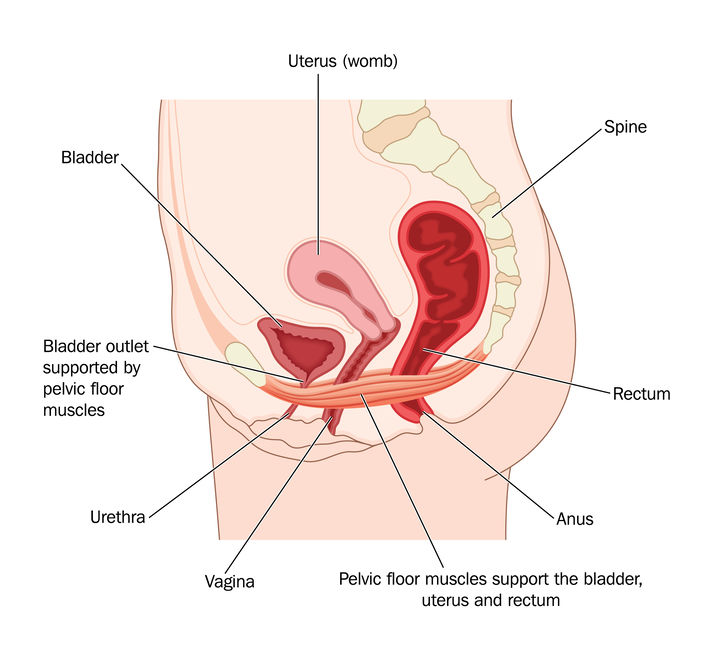Forgetting something? How to remember pelvic floor exercises.
In my work as a Women’s Health Physiotherapist, these days it’s rare for me to come across a woman who hasn’t heard of pelvic floor exercises. Most women have heard of the pelvic floor and seem to be aware that pelvic floor exercises are important for maintaining continence and for good bladder and bowel health.
Certainly, some women still don’t really know where their pelvic floor muscles are and how to exercise them correctly. A fair bit of my job involves educating women about the location and function of the pelvic floor. (If you are not sure where the pelvic floor muscles are, see the diagram below.)

Like any muscle in the body, the pelvic floor can get stronger by exercising the muscles in the right way. Therefore, it is important that pelvic floor exercises are performed correctly. This involves doing enough repetitions often enough and in the right way for the muscles to get stronger. So, another large part of my job is ensuring each woman can perform pelvic floor exercises correctly, setting an appropriate exercise “prescription” for that individual, and making sure this is progressed based on each person’s ability and functional need.
Once this is all sorted out, it should just be a matter of doing your exercises and things will improve. Simple, right? Sadly not.
Despite the fact that most women know that pelvic floor exercises will help their incontinence and prolapse, even when they know how to do these exercises correctly, one of the biggest barriers to progress I see is that many women forget to do their exercises or cannot manage to “fit them in” to their day.
In many ways, this is not unlike many other health messages. We know we should eat 5 serves of vegetables a day, yet only 7% of Australian adults actually do this. We know we should do a minimum of 150 minutes of cardiovascular exercise every week, but less than half of Australian adults meet this target. We don’t always do the things we know are best for us and our health.
I get it. Pelvic floor muscle exercises can be boring. Like any muscle strengthening exercise, it takes time to see any difference in your symptoms - you just want a quick fix. You’ve got a busy life and you really cannot fit in one more thing. You meant to do them, and you got busy and forgot. You started doing them, things felt better for a while, so then you stopped – now it’s worse again! You planned to do them at night in bed, but you’ve found they’re really good for curing your insomnia as they put you to sleep in a flash. Yes, I’ve heard it all!
The question is, how can you remember to do your pelvic floor exercises?
I find the following tips can work well for any kind of exercise program, but especially pelvic floor exercises. It’s important to work out what works best for YOU and your lifestyle.
1. Make pelvic floor exercises part of your daily routine.
Women who manage to incorporate their exercises into their daily activities seem to manage to do them more consistently. You could do pelvic floor exercises when you are having a shower, brushing your teeth, making lunches for the next day, having a coffee break. It doesn’t really matter, as long as the activity allows you time and the necessary concentration to do your exercise set.
Of course these ideas work better for those who can do their exercises in standing and sitting. I try to progress all women to these functional positions as soon as possible, but sometimes you need to start lying down if you are having trouble getting the right action or your muscles are very weak.
2. Set a reminder and schedule in the time.
There are lots of ways you can do this. Set reminders in the calendar on your phone. Put it in your diary. Use an app with a reminder setting (there are lots of free pelvic floor apps that have reminder settings). If you make the time to do your exercises, you are more likely to do them.
3. Make technology your friend.
There are apps for almost everything these days. There are many pelvic floor exercise apps (or kegels, as the Americans call them). Unfortunately, a lot of the free ones are not customizable and often set the starting point for exercises too low, which limits their usefulness. If you are happy to spend about $5 though, there is a great app called “Squeezy” which was developed by the NHS in the UK. This one is customizable, allows you to set reminders and gives you visual or audio cues to help count you through your exercises. You can even share data with your Women’s Health Physio so they can track your compliance if you feel you need this motivation.
4. Follow up regularly with a Women’s Health Physio.
Studies have shown women who follow up regularly with their Physio have better outcomes. There are several reasons for this:
- Like all exercises, pelvic floor exercises need to be progressed so you continue to improve. This can include changing the hold time and repetitions, but also making sure your program meets your functional needs.
- Regular follow up also keeps you accountable. There’s nothing like having to report back to someone to make sure you keep on track. Many people find if they are only accountable to themselves they are more likely to stray off track.
If you find you are forgetting your exercises, give these ideas a go and see if it makes the difference you need. Do it now … before you forget!
Yours in pelvic health.
Jenny
